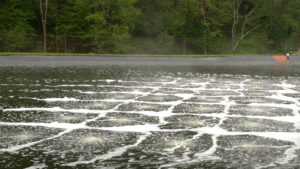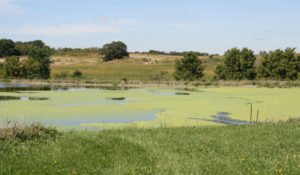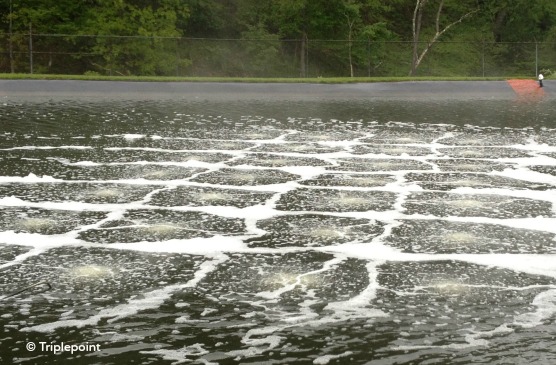To paraphrase an old saying, some companies that sell hammers try to turn every problem into a nail. We’re not that kind of company.
We manufacture lagoon aeration, among other things, and while we know that sufficient aeration and mixing in a lagoon can improve treatment and prevent problems like odor and sludge buildup, we also know that adding aeration is not always feasible.
Our mission is to help Lagoons Do It Better, in whatever form that may take, and to help you stock your toolbox with all the best solutions. One good tool is bioaugmentation, or biological lagoon additives like bacteria, micronutrients, enzymes, and stimulants. In this episode of LDIB-TV, Patrick Hill talks to John Dinneen, leader of technical service at Aquafix (teamaquafix.com), a leading microbiological lab, about how biological lagoon additives can treat BOD, ammonia, and sludge. (Check our our previous blog and video on how Aquafix treats algae and duckweed.)
What makes Aquafix different? Science!
In The Biology and Troubleshooting of Facultative Lagoons, author Michael Gerardi states, “Bioaugmentation is a technology not an art. It requires the selection of appropriate organisms and population sizes to be added. It also requires the selection of a proper addition point or points as well as proper frequency of addition of cultures.”
 Aquafix has a state-of-the-art biological lab and partnerships with researchers at the University of Wisconsin to develop solutions to wastewater problems. Their focus is on steering enzyme reactions because “every action in wastewater requires enzymatic pathways,” whether it’s breaking up grease or removing ammonia.
Aquafix has a state-of-the-art biological lab and partnerships with researchers at the University of Wisconsin to develop solutions to wastewater problems. Their focus is on steering enzyme reactions because “every action in wastewater requires enzymatic pathways,” whether it’s breaking up grease or removing ammonia.
Aquafix works in partnership with wastewater operators and uses sampling to determine the cause of effluent issues and to craft a targeted solution.
All of Aquafix’s products are made in-house, at their Madison, Wisconsin bug factory.
How important is bug count?
Bug count is less important than having the right kind of bugs and the food they need to thrive. For example, Aquafix’s cold-weather nitrifiers blend is cultured in a high BOD environment under refrigeration so they’re acclimated to winter lagoon conditions. When bacteria are released into the lagoon, they are ready to rock and roll—targeted to the unique conditions, as active as possible, and ready to do the job they were sent to do.
When to consider using biological lagoon additives
 Biological lagoon additives can improve treatment in all types of lagoons: facultative, anaerobic, and mechanically aerated. Aeration and bioaugmentation work hand in hand: A well designed and effective aeration system, like Triplepoint’s Ares Aeration®, provides the high dissolved oxygen and mixing that bacteria love. Here are some situations when you might want to consider bioaugmentation:
Biological lagoon additives can improve treatment in all types of lagoons: facultative, anaerobic, and mechanically aerated. Aeration and bioaugmentation work hand in hand: A well designed and effective aeration system, like Triplepoint’s Ares Aeration®, provides the high dissolved oxygen and mixing that bacteria love. Here are some situations when you might want to consider bioaugmentation:
At startup: Seeding a new lagoon with bacteria can jump-start the treatment process by helping bacterial colonies get established.
To reduce sludge: Especially in summer, when warmer temperatures boost bacterial growth, adding a product like VitaStim can help rapidly degrade accumulated sludge and reduce the need to dredge.
 To treat algae and duckweed: Excess algae and duckweed can increase TSS and cause coliforms to spike due to lack of UV penetration. Combining an algaecide or herbicide with a biocatalyst like Aquafix’s Pondzilla Pro will kill and degrade surface growth and improve water clarity and effluent quality. Watch our video, Controlling Lagoon Algae and Duckweed with Aquafix, for details.
To treat algae and duckweed: Excess algae and duckweed can increase TSS and cause coliforms to spike due to lack of UV penetration. Combining an algaecide or herbicide with a biocatalyst like Aquafix’s Pondzilla Pro will kill and degrade surface growth and improve water clarity and effluent quality. Watch our video, Controlling Lagoon Algae and Duckweed with Aquafix, for details.
To recover from a toxic event: Surges in BOD; fats, oil, and greases; or toxins or metals from industrial processing can destroy bacterial colonies. Reseeding can speed recovery and get treatment back on track.
To optimize lagoon treatment: Bioaugmentation boosts the health and function of a lagoon’s existing biomass. And, since bacteria are consumed by higher life forms or wash out in effluent, it’s good to reseed from time to time, especially those that work on tougher compounds like oils, greases, and starches.
Biological Lagoon Additives: Overcoming a bad reputation
Bioaugmentation has gotten a bad rap in the past, with some salesmen making pie-in-the-sky claims of effectiveness and products inevitably falling short, which tarred the entire industry with the brush of “snake oil.”
If you are considering bioaugmentation, look for a company that can provide testing to determine the proper protocol for your lagoon, does their own manufacturing, and stands behind their products.
 For more information about how Aquafix’s bioaugmentation products can improve treatment in your lagoon, visit their website, teamaquafix.com, or call 888-757-9577. Tell them Triplepoint sent you for a 20% discount on your first order.
For more information about how Aquafix’s bioaugmentation products can improve treatment in your lagoon, visit their website, teamaquafix.com, or call 888-757-9577. Tell them Triplepoint sent you for a 20% discount on your first order.

